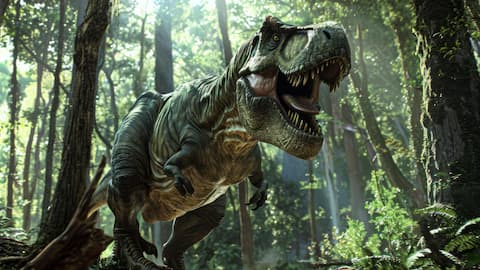T. rex: The 15-tonne dinosaurs capable of crushing cars
What's the story
A recent study has unveiled that the Tyrannosaurus Rex (T. Rex), often referred to as the King of Dinosaurs, was a colossal creature that once dominated the Earth, weighing an astounding 15 tonnes. This weight is 70% heavier than previously estimated, according to computer models used by researchers. These models also revealed that T. Rex's length was a quarter more than earlier thought, measuring up to 15 meters instead of the previously believed 12 meters.
Size speculation
Researchers question previous estimates of dinosaur sizes
Dr. Jordan Mallon, one of the authors of the study, expressed uncertainty about previous size estimates for large fossil animals like T. Rex. Mallon stated that their study indicates that the fossil record does not provide a clear understanding of the absolute sizes that large fossil animals like T. Rex might have reached. He found it fascinating to consider a 15-tonne T. Rex from both a biomechanical and ecological perspective.
Tooth truths
T. rex's iron-coated teeth: A key to its predatory success
In addition to their impressive size and weight, T. Rex had iron-coated teeth that helped in tearing apart prey, according to a recent study. Dr. Aaron LeBlanc from King's College London, the study's lead author, compared T. Rex's teeth to those of Komodo dragons, which also have curved, serrated teeth for ripping prey. However, LeBlanc noted that current technology cannot determine if fossilized dinosaur teeth contained high iron levels due to chemical changes during fossilization.
Debate
Limitations of measuring dinosaur size
The authors emphasize that the debate over the largest fossil animals is complicated by the rarity of complete dinosaur remains. Many species are known from only a few specimens, leading to potential misconceptions about their true size. Hone from Queen Mary University of London notes that this issue extends beyond just T. rex and affects all dinosaurs and many other fossil species. He argues that determining the "biggest" based on a limited number of skeletons is not very meaningful.
Challenging quest
Larger dinosaurs may have existed, but finding them is unlikely
Although museum displays feature impressive dinosaur skeletons, evidence indicates that even larger individuals of these species may have existed. Hone mentioned in the press release that some isolated bones suggest the presence of larger specimens than those currently represented. However, it is highly unlikely that paleontologists will ever discover the largest individuals of a dinosaur species.
